12 Ways to Build Literacy in the Secondary Classroom: secondary teachers share ideas for literacy in high school!
I love books. Love, love reading. I collect books and decorate with books. Most ELA teachers adore the written word and share my love.
Actually, many of us became English teachers because we want to share our love of reading with students. Among lesson plans, meetings, modifications, and other parts of the job, showcasing literacy may have fallen. Teaching literacy in high school is important, though. How can we promote literacy in high school?
I reached out to eleven teacher bloggers with the simple question: How can we purposefully build literacy in the secondary classroom? Can teens see informational texts as part of everyday reading? What works for older students will not be what works for younger students. We secondary teachers need new approaches for promoting literacy in high school.
Below, you’ll find honest and real ways to get older students reading, understanding the importance of literacy, and seeing the positive effects of knowledge. As we start school this year, implement a few of these practices to engage your older students with literacy.
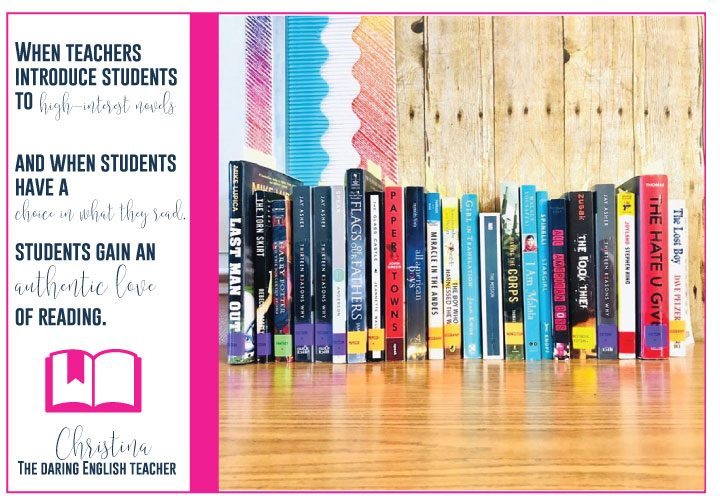
Student-choice literature circles
One way that Christina, The Daring English Teacher, creates a literacy-rich classroom is by facilitating student-choice, high-interest literature circles. When teachers introduce students to high-interest novels, and when students have a choice in what they read, students gain an authentic love of reading.
To facilitate the student-choice literature circles, Christina first introduces all of the books to her students. You can do this by including a first chapter Friday routine into your classroom or by hosting a traditional book tasting activity. Once students select their books, it is time to dedicate class time to the literature circles. One key aspect in facilitating successful literature circles is by making sure that the students set their own group deadlines and expectations. This provides students with agency and ownership of the work.
Finally, to hold students accountable, my students use these Response to Literature Task Cards to discuss the events in the book. They also use various pages from this Sticky Note Literary Analysis resource to dive deeper into the novel and conduct high-level analysis conversations about the books. As a culminating activity, students work together to create a one-pager representing their books. For group one-pagers, she prefers to use a larger size paper. Secondary literacy can be easy to approach!

Student Conferences
Melissa, author of Reading and Writing Haven, shares that a key to creating an inspiring reading culture with older students is building relationships. A key way to build relationships through books (and one that is growing in the secondary education classroom) is through conferring. Books are windows into the world, and when we have meaningful conversations with students about characters, conflicts, themes, and connections, we can learn more about our tweens and teens. Teaching literacy in high school is often about relationships.
Conferencing with readers basically means that the teacher and student sit down one-on-one to have a meaningful conversation about the book a student is currently reading. At the beginning of the year, teachers sometimes focus on engagement questions (those that encourage students to open up about their prior reading experiences – even negative ones!) so that we can get a better picture of who they are as a reader.
Those conversations progress as the year continues, and, often, questions are tied to standards and reading strategies. For example, if you are using a whole-class text (let’s say a short story, novel excerpt, or picture book) to model how conflict impacts the theme, give students a specific strategy to help them apply that same skill to their independent reading books. When conferring with them, ask students to talk about how they are seeing the conflict shape the theme specifically. Even if we haven’t read the book, we can tell whether or not students can meet the standard. All we need is a snippet into their thinking, and then we can help to push them a little further along on the learning continuum by setting a goal for the next reading conference.
These free emoji reading response questions can be used as exit tickets and are helpful with determining whether students need a one-on-one conference for the standard-related question or whether the entire class needs a mini lesson. (It also makes for great literacy classroom displays!)
When teaching virtually, teachers can engage with students on tech platforms like Flipgrid, Padlet, and even journal prompts via Google Drive (albeit not at the same pace, but still worthwhile) to talk about reading.
If you’d like more details about how to make time for conferring with older students or how to choose reading goals and strategies for students to practice, you can read more about conferring with secondary readers on Melissa’s blog, Reading and Writing Haven. As a literacy coach, she has tons of ideas for secondary literacy.

Graphic Novels
As teachers re-examine their classroom libraries to include multiple and diverse perspectives that provide windows and mirrors for students, let’s chat about graphic novels. Staci from Donut Lovin’ Teacher wants to remind us that graphic novels are just as powerful and valid as other types of text! In fact, they shouldn’t just be part of our classroom libraries, they should also be part of the curriculum! (They are also beautiful, making graphic novels perfect literacy classroom displays!)
Teaching graphic novels entails learning how to read a graphic novel and can be used to help your students become better storytellers and writers that use descriptive details. Graphic novels can also be used to have students compare and contrast text types and it allows students to try out being graphic novelists themselves!
There are many familiar book titles that have become graphic novels such as The Giver, A Wrinkle in Time, Anne of Green Gables, and The Odyssey, to name a few. There are also so many newer titles such as The Unwanted: A Story of Syrian Refugees, They Called Us Enemy, and The Best We Could Do that can provide historical context and connections to current events and experiences. If you’re looking for more titles, check out these graphic novels Staci thinks will make a great addition to an identity unit, or even just your classroom library! Teaching literacy in high school will take a variety of books.
Student work displays
Tanesha at Love Tanesha displays student work in the classroom to create community and enhance literacy learning. Doing so provides talking points for teaching literacy in high school. Below are a few best practices from Tanesha before getting started:
- communicate the purpose of work displays early in the year
- ask students for permission to display work
- don’t display grades
- when possible use typed work
- highlight the skill(s) in the work
Hanging and spotlighting student work is a great and simple way to build community and showcase student authenticity. Tanesha loves using work displays to highlight the range of ideas and interpretations in writing. Regardless of the genre, Tanesha believes that the classroom belongs to the students and should celebrate strong work habits, unique ideas, and overall growth. To build literacy in the secondary classroom, display student work.

Project Lit
Staci Lamb from The Engaging Station creates a literacy-rich environment by building a classroom library that is inclusive and features a variety of lived experiences and perspectives with the help of the Project Lit Community.
In 2019, Staci and her friend, Anna (@klechuponagoodbook) started the Project Lit chapter at their school. They asked their friends, family, and colleagues for help in building their libraries through an Amazon wishlist. Not too long after, they had hundreds of books readily available for their book clubs. With help from others, they were soon teaching literacy in high school.
If you need a starting ground for adding books to your library, Project Lit (@projectlitcomm on Instagram) is a great place to start. You can also check our Staci’s blog post featuring a variety of ways to build your classroom libraries on a budget.

Home Connections
Lauralee (you’re on her blog!) cultivates relationships with parents so that students experience a uniform message: literacy is important. An important factor to build literacy in the secondary classroom is to share your literacy goals with the adults in students’ lives. When she meets with parents for the first time, she explains her classroom’s methods:
- A variety of books (including The Hate U Give), genres, and authors during First Chapter Fridays.
- A student-arranged classroom library.
- Frequent trips to the school library.
- Guest readers.
- Student choice in independent reading activities.
When you build relationships with the people at home, students hopefully learn that books belong everywhere. She’s experienced fabulous support for independent reading and lit circles in her classroom because parents knew the research behind student choice. Furthermore, she’s seen magical transformations like parents reading alongside their students. Reading can become an important part of students’ lives when their parents understand what you’re trying to accomplish.
A special note: She does not share these posters with students. Teaching literacy in high school requires a relationship with parents. She shows the statistics because as a parent, she wants to know them. However, she does not stress that data with students.

A Purposefully Designed Classroom Library
When space for a classroom library is a concern (or just nonexistent!) Amanda from Mud and Ink Teaching has you covered. Classroom libraries are important parts of a literacy rich classroom, but not all classrooms belong to a teacher all day long.
What’s most important, especially in this case, is creating a classroom routine that highlights specific titles and a small, dedicated space to the MOST loved books. For Amanda, that means hosting First Chapter Fridays every week and giving students a sneak peek into the first page of a great, new book. Students use a Book Log Tracker to color and indicate their favorites and future reads.
Amanda also has some easy hacks for small classroom spaces, including:
- Using a 3-tier cart to display books
- Moving extra books to a closet, but virtually cataloging them so students can see titles online
- Using QR codes to YouTube videos of book recommendations and reviews
Read more about transforming your classroom library on her website here.

Literacy’s Importance
One way to promote a love for reading in your classroom is to clearly communicate the importance of literacy. Abby from Write on with Miss G has found success by being transparent with her students about why we read. Regularly sharing the research-based benefits of reading literature can help students understand that reading is lifelong learning, exploration, fun, and self-improvement. Many students don’t realize that reading improves empathy, life expectancy, intelligence, and more.
One way Abby loves to explicitly teach the benefits of reading is through “Why Read?” learning stations. Each learning station focuses on a specific reason for reading and pulls in informational text, multimedia, and studies to show students the advantages of reading.
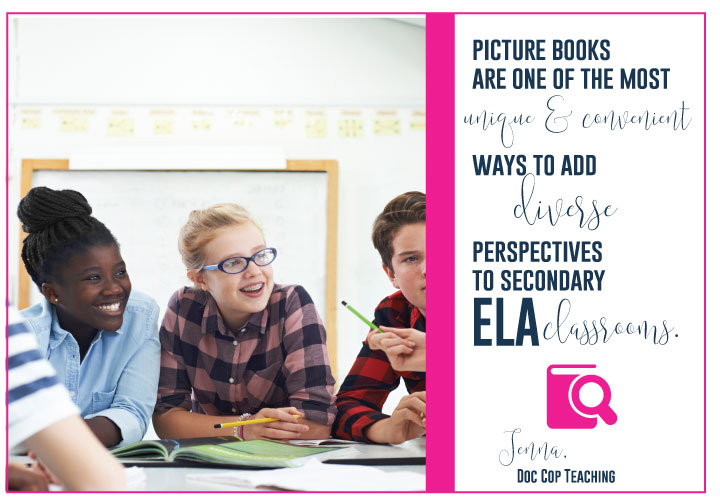
Picture Books
Although they may seem too elementary for secondary ELA, picture books are one of the most unique and convenient ways to add diverse perspectives to secondary ELA classrooms.
That’s why Jenna (@drjennacopper) loves filling her high school library with picture books.
Picture books make great thematic pairings, and students love the nostalgia of a picture book read aloud. Big kids like picture books too, and it’s an academically supported strategy. Picture books are short, accessible, visually stimulating, and engaging, so they give you a great opportunity to introduce new perspectives. To learn more about how Jenna uses picture books to teach literary analysis, click here.

Reading Habits Inventory
Emily Aierstok, founder of Read it. Write it. Learn it., has been implementing independent reading and the reading workshop model in her 7th grade ELA classroom for almost 20 years. Several years ago, she decided to phase out reading logs and prize incentives based on research that showed logs and incentives are ineffective in motivating students to read.
Instead, Emily found that students needed to learn how to build a positive relationship with reading. Students who declared themselves as non-readers or as people who “hated” reading often didn’t have the habits to support reading.
As a result, Emily created the Reading Habits Survey. Unlike a reading log, the Reading Habits Survey asks students to record their habits in order to set goals. Each week, students write down what they read, where they read, and how long they read. They also record the struggles they faced, or things that got in the way of reading.
Every Friday, students in Emily’s classes review their Reading Habits, not for a grade, but for the purpose of setting meaningful goals. Students who are successful in accomplishing their goals share what helped them. Students who struggled share their struggles. Then, students set goals to work through those struggles and build on those triumphs.
The Reading Habits Survey not only helps students, but it also helps inform Emily’s teaching. Emily is more aware of the WHY behind students’ reading habits and can help students build a stronger relationship with reading.
Grab your free Reading Habits Survey here. You can read more about how Emily builds positive reading habits here.
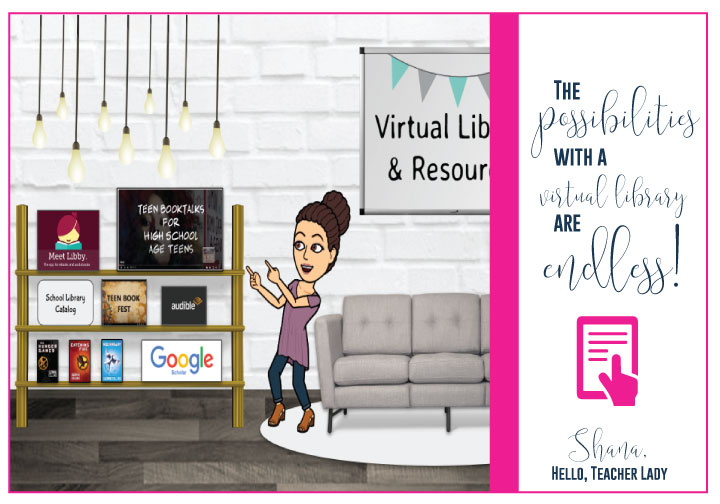
Virtual Classroom Library
Looking to create a literacy-rich classroom from a distance? Shana Ramin from Hello, Teacher Lady suggests creating a virtual classroom library! Follow a few of Shana’s ideas to build literacy in the secondary classroom.
A virtual library is basically a collection of digital resources displayed on a particular platform, such as Google Sites or Google Slides. Digital libraries have been gaining in popularity due to the COVID-19 crisis, but many librarians have been touting their benefits for decades. For a little extra personalization, Shana suggests adding your own Bitmoji — click here to learn how to create a virtual Bitmoji scene in Google Slides.
Wondering what to include in your virtual library? Add links to your school’s library catalog, free audiobook sources like Libby, and other helpful resources such as research databases, YouTube book talks, and more. The possibilities are endless!
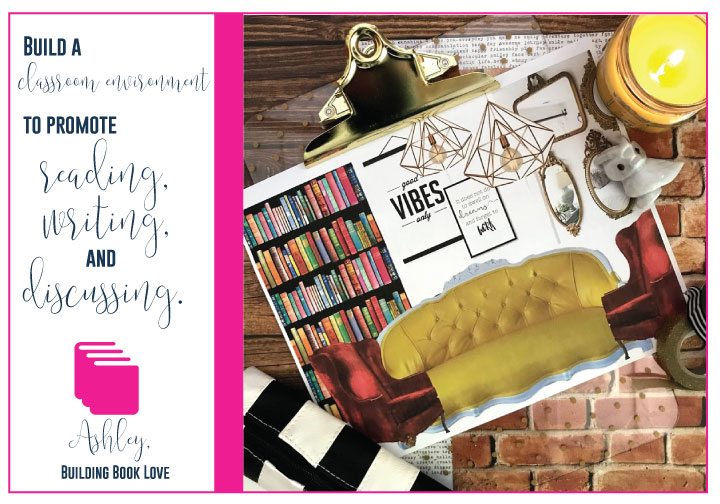
Classroom Decor
Ashley Bible of Building Book Love creates a literacy-rich classroom by celebrating literature through bookish classroom decor and literary displays. She uses beautiful decor to build literacy in the secondary classroom.
You can see her magical library-themed classroom here. It’s full of fun and frugal tips for decorating ELA classrooms such as using old book pages to create free displays.
Speaking of old books, she also has a clever way of using discarded dictionary pages as a meaningful first day activity. It serves double duty as a get-to-know-you assignment and student-centered classroom decor!
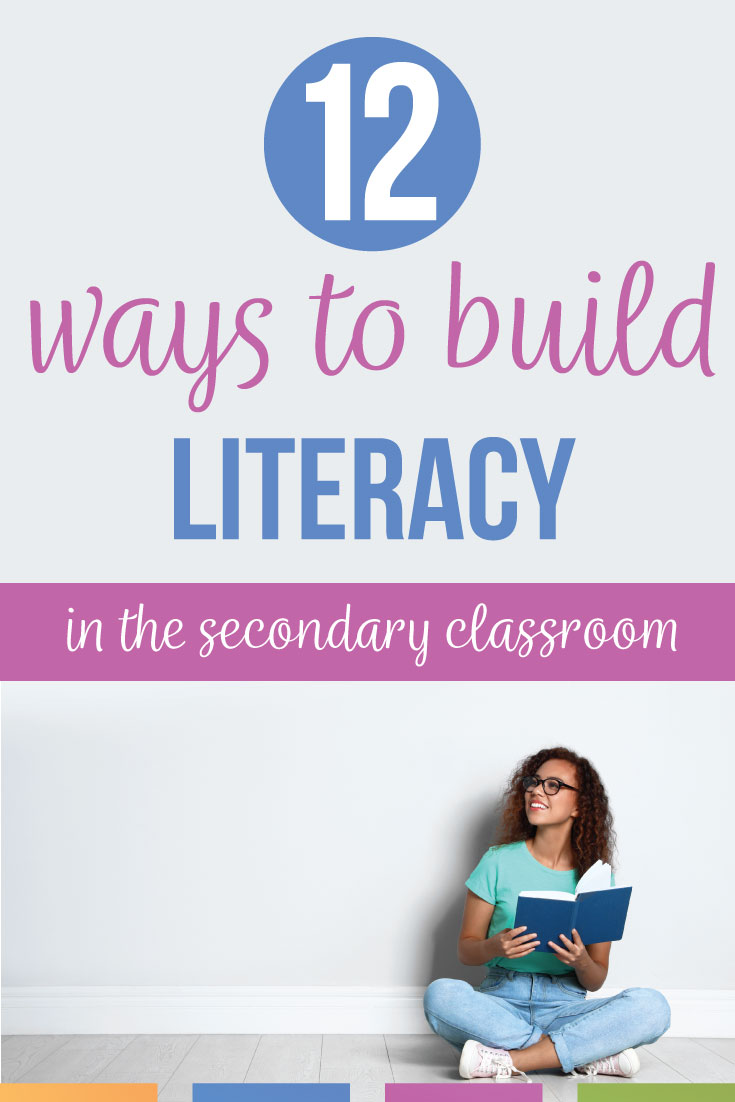
Build literacy in the secondary classroom through intentional practices and relationships, through making a classroom library work for your community, through student choice, through picture books, and through collaborative practices.
This post contains various affiliate links. Please read my disclosures.



